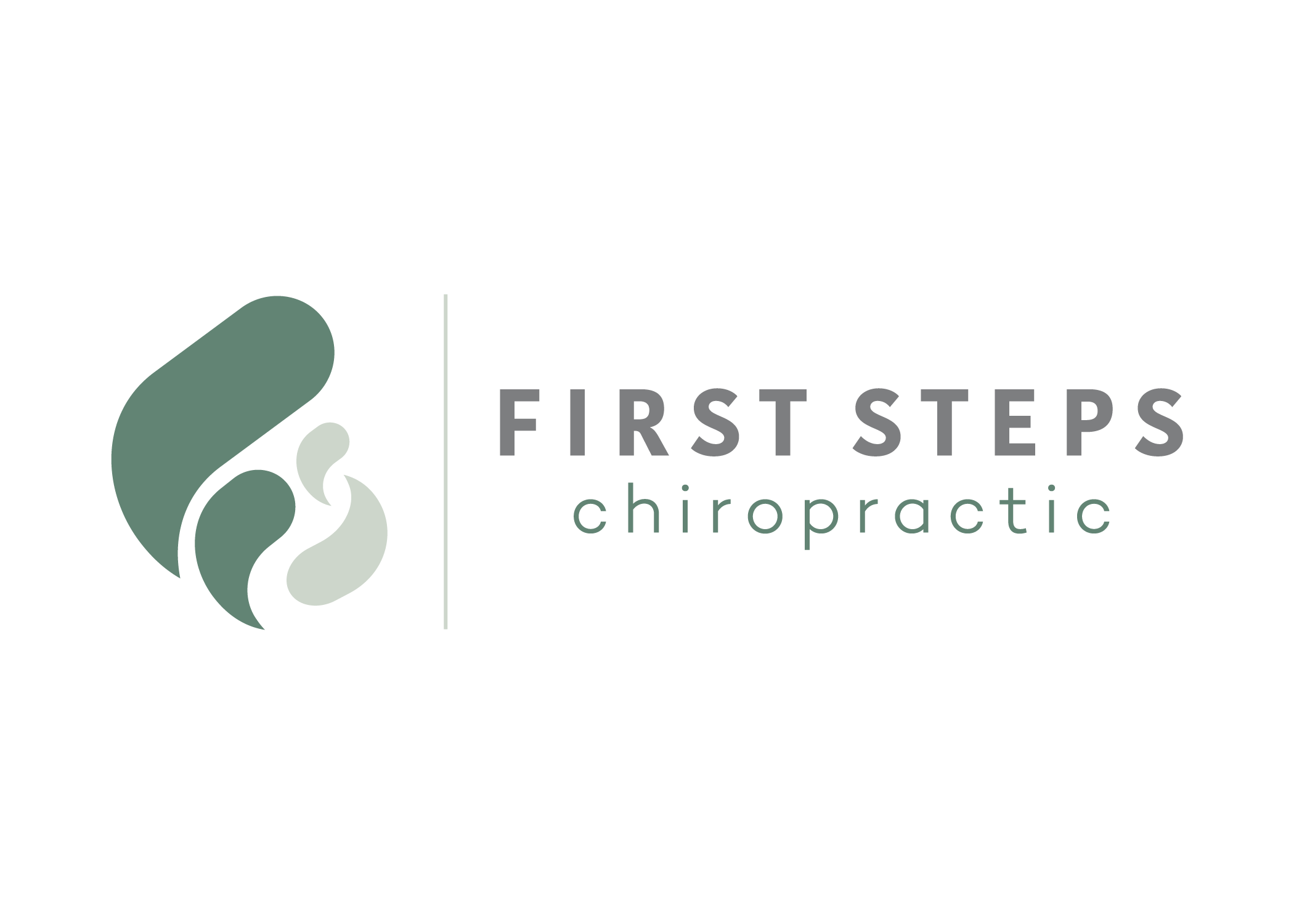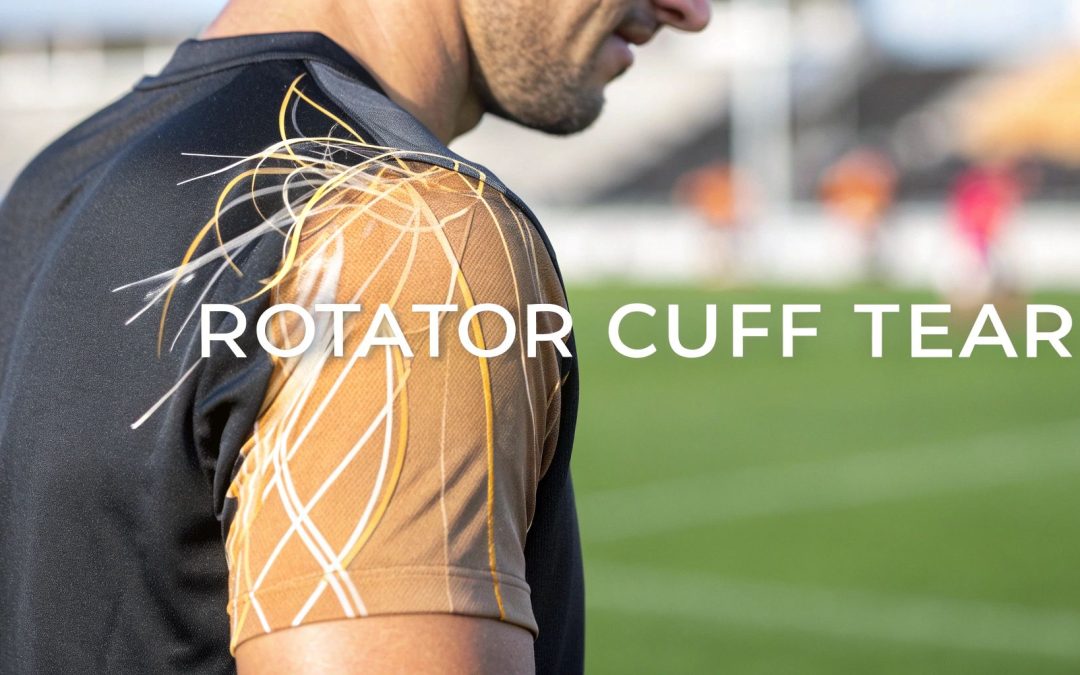That nagging, deep ache in your shoulder might be more than just a passing strain from a busy day. If you're dealing with a rotator cuff tear, the first signs often include a distinct pain that gets worse at night, a surprising weakness when you try to lift your arm, and sometimes a clicking or popping sound when you move it.
Recognizing the First Signs of a Rotator Cuff Tear
Think of your shoulder's tendons as strong, flexible ropes that keep the joint stable and allow it to move. These ropes can either fray gradually over time from simple wear and tear (what’s known as a degenerative tear) or snap suddenly after an injury, like a fall (an acute tear). This explains why your symptoms might have crept up slowly over months or appeared all at once.
Learning to spot these early indicators is the first step toward getting the right help before the problem gets worse.
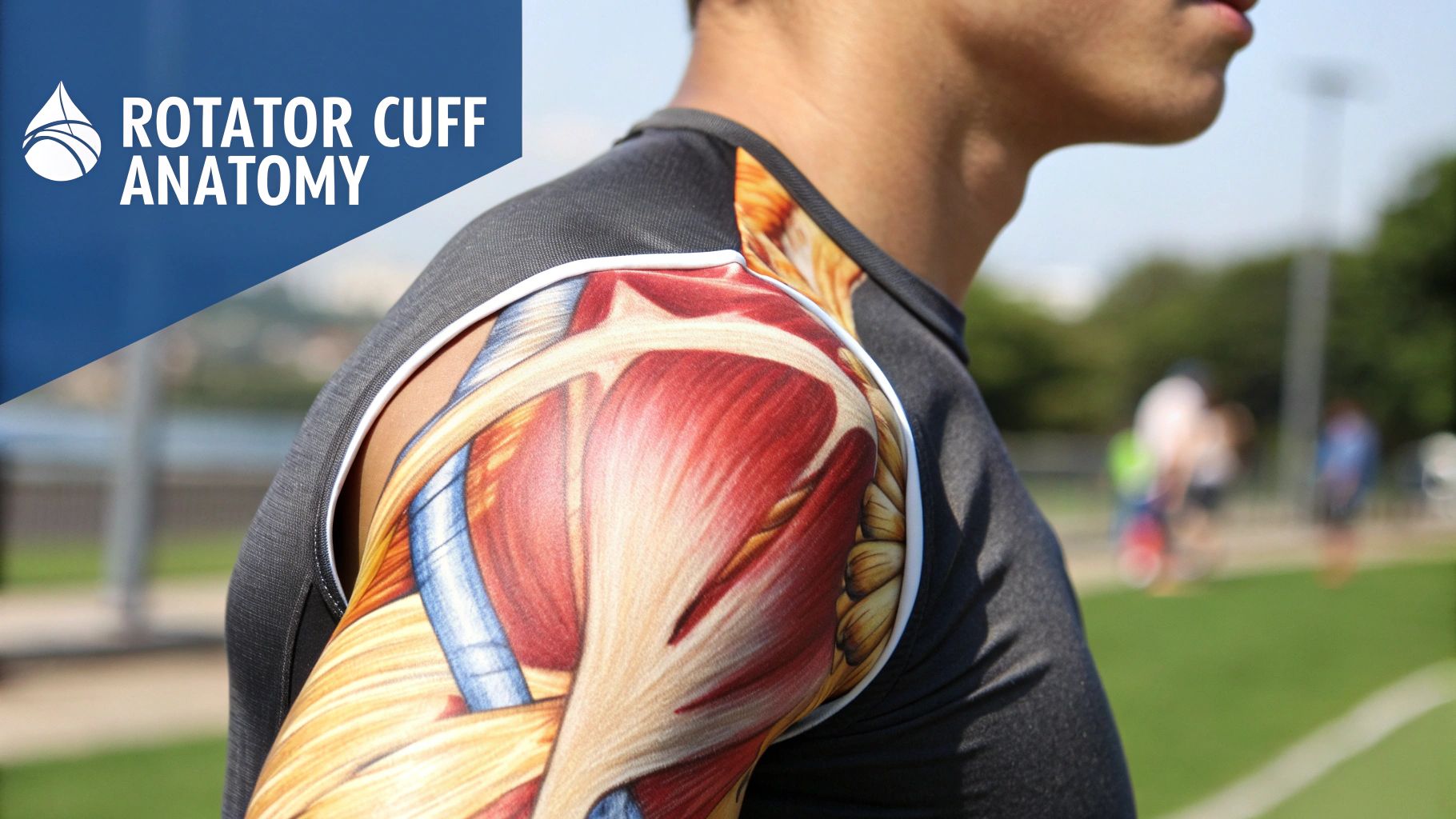
Common Early Warnings
It’s easy to brush off the initial signs, but paying close attention to them is key. These symptoms can have a real impact on your quality of life, especially if the injury is in your dominant arm. Unfortunately, research suggests that public awareness of these signs is pretty low, which often leads to delays in seeking proper care. You can learn more about this in a study on patient awareness of rotator cuff injuries on pmc.ncbi.nlm.nih.gov.
Here’s a quick rundown of the most frequent symptoms that crop up with a rotator cuff tear.
Quick Guide to Early Rotator Cuff Tear Symptoms
| Symptom | Common Description |
|---|---|
| Pain at Rest & Night | A constant, dull ache deep inside your shoulder. It often gets much worse when you lie down on that side to sleep. |
| Weakness with Lifting | You suddenly struggle to lift your arm out to the side or pick up things that used to be no problem. |
| Clicking or Popping | A strange crackling or popping feeling (known as crepitus) when you move your shoulder in certain directions. |
These signs are your body’s way of telling you that something isn't right inside the shoulder joint.
At its core, a torn rotator cuff feels like a deep, persistent ache in the shoulder. The pain often ramps up at night or during simple daily tasks, making it a frustrating and disruptive injury to live with.
Your Shoulder's Anatomy and How a Tear Happens
To really get a handle on the rotator cuff symptoms of a tear, it helps to first picture what’s going on inside your shoulder. Think of your rotator cuff as a team of four muscles and their tendons. They come together to form a “cuff” that wraps around the top of your arm bone, holding it snugly in the shoulder socket.
This team is the unsung hero behind almost every move your arm makes, from hoisting a bag of groceries to just combing your hair. When one of those tendons is damaged, it throws the whole system out of whack, which is what causes that distinct pain and weakness.
How Do Rotator Cuff Tears Happen?
A tear in this critical group of tendons usually happens in one of two ways. Figuring out which path your injury took can offer some big clues about what you’re feeling and why.
- Acute Tears: These happen in a flash, usually because of a specific accident. Maybe you fell and tried to catch yourself with an outstretched arm, or you tried to lift something way too heavy. The force is just too much for the tendon to handle, and it rips suddenly.
- Degenerative Tears: This is the more common scenario. Over many years, things like aging, repetitive overhead motions (think of a painter or a tennis player), and even reduced blood supply can cause the tendon to fray like an old rope. Eventually, it just gives way under normal stress.
And these injuries are more common than you might think. Rotator cuff tears are a widespread issue, with studies showing they affect 25% of people in their 60s and a staggering 50% of those in their 80s. You can learn more about how common these tears are in this detailed study on ncbi.nlm.nih.gov.
The cause of your tear—whether it was a sudden snap or a slow fraying over years—directly influences the symptoms you experience. An acute tear often brings immediate, intense pain, while a degenerative tear might start as a dull, manageable ache that slowly worsens.
Knowing this difference gives you valuable context for the symptoms you're noticing. To dive deeper into how these conditions are handled, you might find our guide on managing rotator cuff injuries helpful.
The Telltale Symptoms of a Torn Rotator Cuff
When your rotator cuff tears, the feeling is often much more than just a simple ache. It creates a very specific pattern of pain and weakness that can throw a wrench into your most basic daily activities. Knowing these key signs is the first step toward figuring out what’s wrong and when it's time to get professional help.
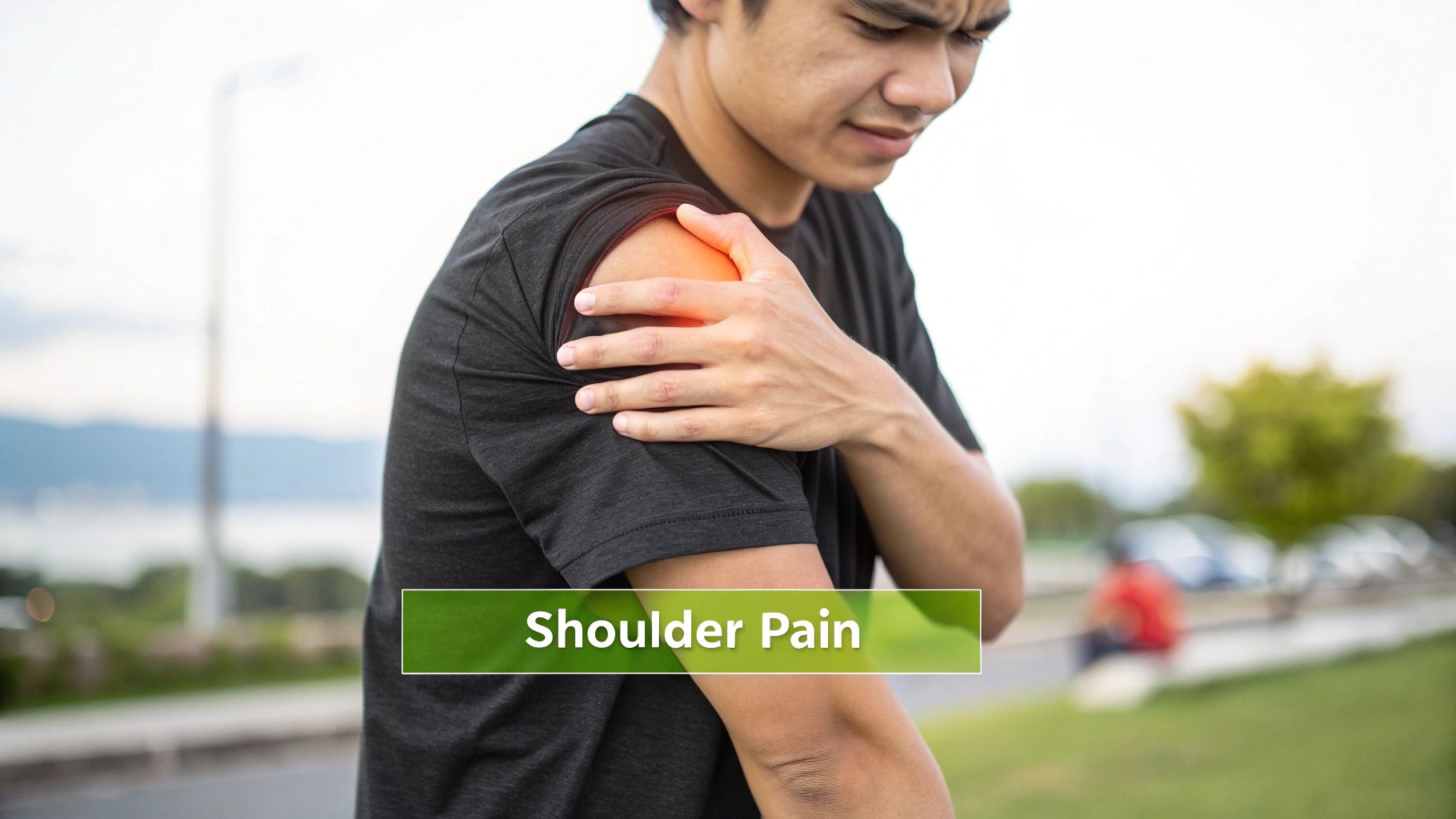
Most people describe a deep, dull ache right on the outside and front of the shoulder. This isn't just surface-level soreness; it feels like it’s coming from deep inside the joint itself. For many, this pain becomes a real problem when the sun goes down.
Night Pain and Sleep Disruption
One of the classic hallmarks of a rotator cuff tear is pain that gets significantly worse when you lie down, particularly if you roll onto the injured side. That pressure on the torn tendon can trigger a sharp, intense discomfort that makes falling asleep—and staying asleep—feel next to impossible.
Honestly, this constant night pain is often the final straw that convinces people to finally see a doctor. That lack of restorative sleep just leaves you feeling exhausted, which makes coping with the pain during the day even harder.
Weakness and Loss of Function
Beyond the pain, a torn rotator cuff leads to a very noticeable weakness in your arm. We're not talking about a general loss of strength; it’s a specific inability to do certain movements. Simple tasks you’ve always done without a second thought can suddenly become a struggle.
You might notice this weakness when you try:
- Lifting your arm out to your side or straight overhead.
- Reaching behind your back to tuck in a shirt or hook a bra.
- Carrying common objects, like a briefcase or a gallon of milk.
- Doing simple routines like combing your hair.
This loss of function happens because the damaged tendon can no longer control the shoulder joint properly. The result is a lack of power and a feeling of instability. If you're looking for more details, our guide on the symptoms of a rotator cuff tear dives even deeper.
A key indicator of a tear is the disconnect between your effort and the result. You might try to lift your arm with all your might, but it simply won’t respond as it should, feeling heavy and unresponsive.
Another common sign is a crackling or popping feeling known as crepitus. You might hear or feel this grating sensation when you move your shoulder, which is caused by the damaged tissues rubbing abnormally inside the joint.
How Symptoms Change with Tear Size and Type
Not all rotator cuff tears are created equal. The symptoms you feel often give some pretty strong clues about the severity and type of injury you're dealing with. Knowing the difference is the first step toward understanding just how serious your condition might be.
Generally, we categorize tears into two main types: partial-thickness and full-thickness.
Imagine a rope that’s starting to fray but is still holding together. That’s a good way to picture a partial-thickness tear. The tendon is damaged and thinned out, but it hasn’t completely separated from the bone. This usually leads to pain that comes and goes, especially when you're reaching overhead, but you probably still have a decent amount of strength.
Now, think about that same rope snapping completely in two. That's a full-thickness tear. A piece of the tendon has pulled away from the bone entirely. As you can guess, this brings on more severe, constant symptoms and a significant loss of function.
Acute vs. Chronic Tear Symptoms
How the injury happened also plays a big role in what you'll experience. An acute tear—the kind you get from a sudden fall or lifting something too heavy—hits you all at once. People often report a sharp, immediate pain and sometimes even a snapping sensation at the moment of injury. Right after, you'll likely feel a sudden, undeniable weakness in your arm.
On the other hand, a chronic tear is sneaky. It develops slowly over time from repetitive motion and general wear and tear. The symptoms start subtly, maybe as just a dull ache in your shoulder, and then gradually get worse over months or even years.
The crucial thing to remember is that an untreated full-thickness tear can get bigger over time. This can lead to chronic pain and make it incredibly difficult to use your arm for everyday tasks. Getting an early diagnosis is key to stopping the damage from getting worse.
This chart gives a quick look at how doctors diagnose rotator cuff tears and how effective each method is.
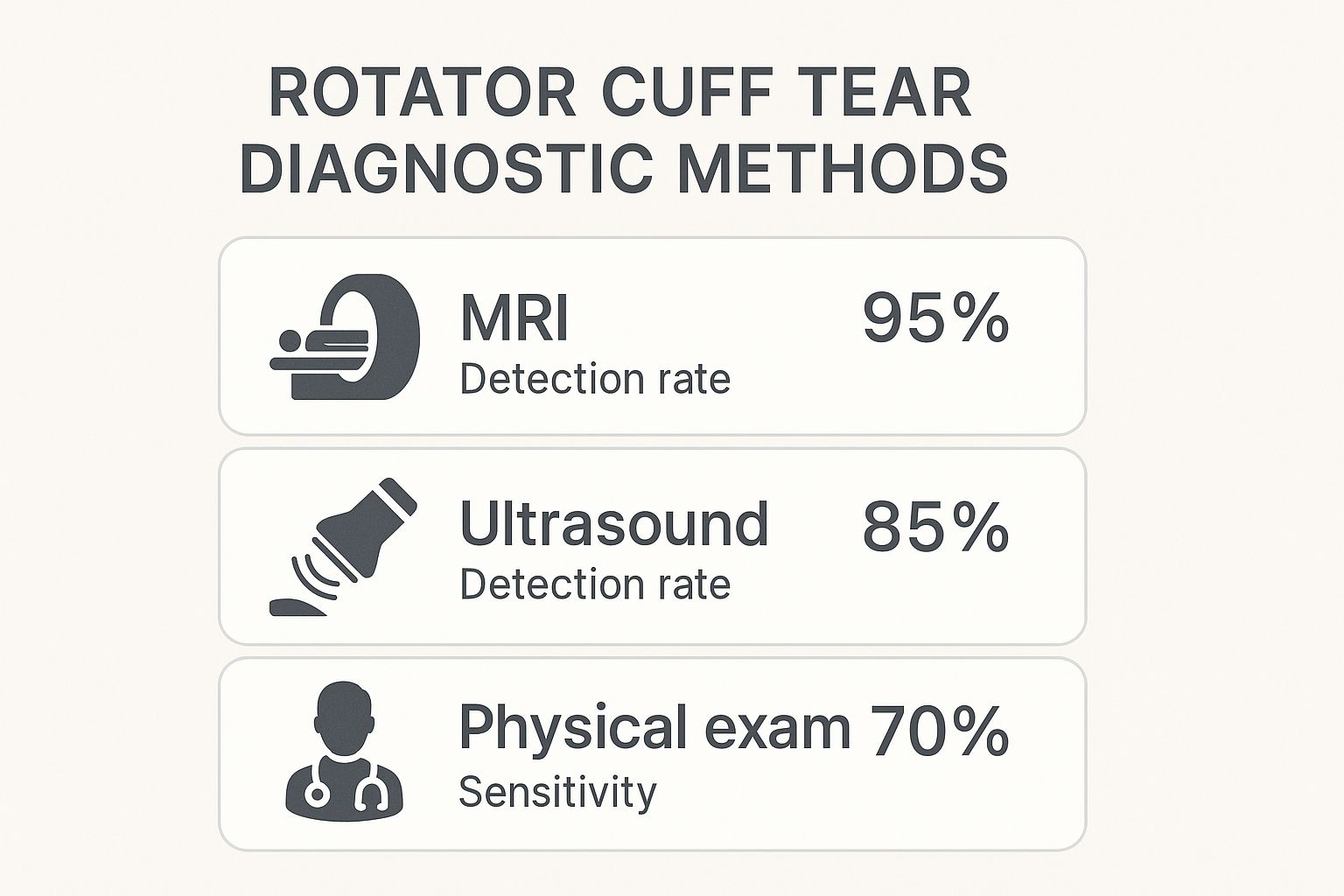
A physical exam is always the first step, but imaging tests like an MRI or ultrasound are what really give us a clear picture of what’s going on inside the shoulder.
It might surprise you to learn just how common these injuries are. Rotator cuff tears affect roughly 23% of adults globally, making them one of the most frequent tendon issues people face. The severity of your symptoms often links directly back to the size of the tear and the overall health of the muscle. For a deeper dive, you can learn more about the global impact of these injuries on jbjs.org.
Symptom Comparison: Partial vs. Full-Thickness Tears
To make it easier to spot the differences, let's break down how the symptoms typically stack up between a partial and a full tear.
| Symptom Aspect | Partial-Thickness Tear | Full-Thickness Tear |
|---|---|---|
| Pain Level | Dull, aching pain, often worse with specific movements (like reaching up). | More intense, constant pain, even when resting. Night pain is very common. |
| Weakness | Mild to moderate weakness. You can still lift your arm, but it might be painful. | Significant weakness. Lifting the arm away from the side is difficult or impossible. |
| Range of Motion | Pain may limit motion, but the joint can still move through a full or near-full range. | Both active and passive range of motion are often severely limited due to pain and weakness. |
| Night Symptoms | Pain may worsen at night, especially when lying on the affected shoulder. | Severe night pain that frequently disrupts sleep is a hallmark symptom. |
| Crepitus (Cracking) | Occasional clicking or popping sounds with movement. | More pronounced grinding or cracking sensation (crepitus) is common. |
This table is a general guide, of course. Everyone's experience can be a bit different, which is why getting a professional diagnosis is so important if you suspect you have a tear of any size.
When Your Shoulder Pain Warrants a Doctor's Visit
It’s one of the most common questions I hear: "How do I know if this is a real injury or just a minor strain?" We all get aches and pains, but sometimes your body sends you clear signals that it’s time to call in a professional. Listening to those signals is key, because ignoring a potential rotator cuff tear can turn a manageable problem into a much longer, more complicated recovery.
So, when is it time to schedule an appointment? You should absolutely get your shoulder checked out if you’re experiencing any of these tell-tale signs:
- The pain has stuck around for more than a week, even after you’ve been resting and icing it.
- You feel a distinct weakness that gets in the way of your daily routine, making simple tasks like lifting a grocery bag or reaching into a cabinet feel difficult.
- The pain didn't just appear—it started with a specific, sudden injury, like a fall or trying to lift something way too heavy.
- You actually heard or felt a "pop" at the moment the injury happened.
What to Expect During Your Evaluation
Knowing what to expect can take a lot of the anxiety out of a doctor's visit. The first thing that will happen is a physical exam. Your doctor will gently guide you through a series of simple tests right there in the office to check your arm's strength and how well it moves. This initial hands-on evaluation is great for zeroing in on what’s causing the pain.
Early diagnosis is crucial for a better outcome. Delaying a visit can allow a small, manageable tear to become larger and more complex, potentially limiting your future treatment options.
If the physical exam points toward a possible tear, the next step is usually imaging. An MRI or ultrasound gives your doctor a clear picture of the tendons and soft tissues inside your shoulder. This confirms if a tear is there and, just as importantly, shows its size and severity.
This isn't just about getting out of pain now; it's about protecting your shoulder for the long haul. And for anyone dealing with nagging discomfort, learning how to manage chronic pain can be an invaluable part of your overall recovery plan.
Frequently Asked Questions About Rotator Cuff Tears
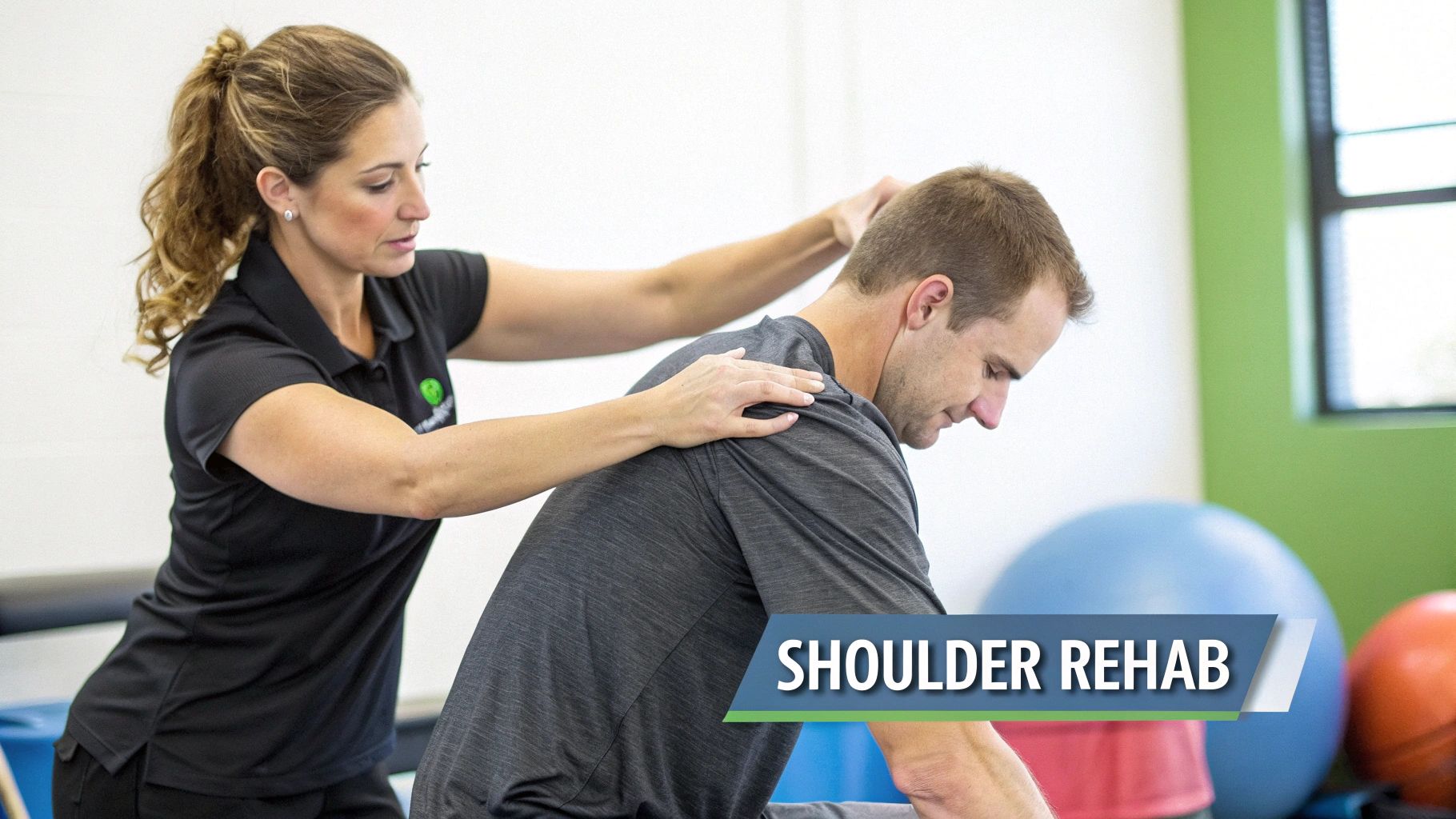
Learning you might have a rotator cuff tear naturally brings up a lot of questions. We get it. Below are some clear, straightforward answers to the most common concerns we hear from patients, helping you figure out your next steps on the road to recovery.
Can a Rotator Cuff Tear Heal on Its Own?
While our bodies are incredible healers, a significant rotator cuff tear is one of those injuries that rarely gets better all by itself. A big reason for this is that the tendons in this part of the shoulder don't get a lot of blood flow, which is crucial for any real tissue repair.
Now, small or partial tears might not necessarily get worse. They can often be managed well with physical therapy, rest, and learning how to modify your activities to take the strain off.
But a full-thickness tear is a different story. These can actually get bigger over time, leading to worse rotator cuff symptoms of a tear and a greater loss of function. This is exactly why getting a professional diagnosis is so important—it determines the right path forward for your specific injury.
The bottom line is that while symptoms can improve with non-surgical care, the torn tendon itself is unlikely to reattach to the bone without intervention.
What Activities Should I Avoid?
The most important rule here is simple: listen to your body. If it hurts, stop. As a general guideline, you'll want to avoid any activities that put extra stress on that shoulder joint while you're healing.
Common movements you should try to steer clear of include:
- Heavy or overhead lifting, like putting a heavy box on a high shelf.
- Sudden, forceful reaching for something.
- Throwing motions, which put a massive strain on the rotator cuff.
- Sleeping on the affected shoulder, as this direct pressure can ramp up inflammation and that nagging night pain.
Giving these movements a rest allows the injured tendon to calm down and can keep the tear from getting any worse.
How Is a Rotator Cuff Tear Diagnosed?
Getting a solid diagnosis is a multi-step process. It always starts with a conversation about your medical history and the specific rotator cuff symptoms of a tear you’ve been dealing with.
Next up is a physical exam. Your doctor will test your shoulder's strength and range of motion through a series of specific, guided movements. If that exam points toward a tear, the next step is usually imaging to confirm it.
An MRI is often called the gold standard because it gives an incredibly detailed picture of the soft tissues, showing the exact location and size of the tear. An ultrasound is another great, accessible tool that’s highly effective at visualizing the tendons to lock in a diagnosis.
Understanding your symptoms is the first step toward getting better. At First Steps Chiropractic, we specialize in getting to the root causes of musculoskeletal issues with gentle, neurologically-focused care. If you're struggling with shoulder pain, schedule a complimentary consultation with First Steps Chiropractic to see how our personalized approach can help you heal.
